英语倒装句类型
- 格式:doc
- 大小:28.00 KB
- 文档页数:6
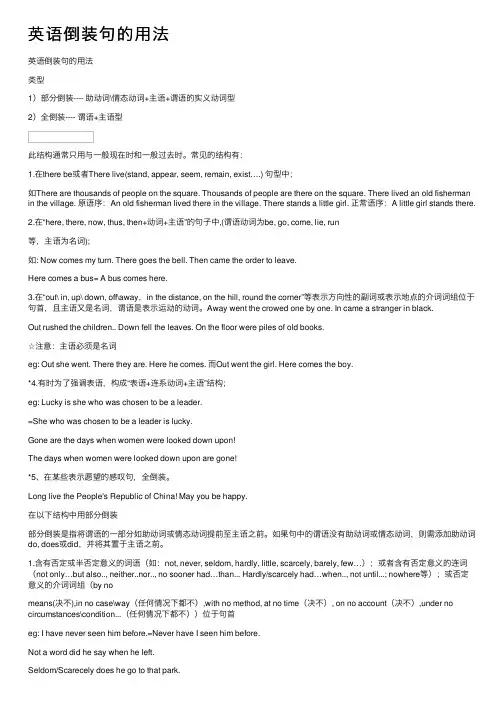
英语倒装句的⽤法英语倒装句的⽤法类型1)部分倒装---- 助动词\情态动词+主语+谓语的实义动词型2)全倒装---- 谓语+主语型此结构通常只⽤与⼀般现在时和⼀般过去时。
常见的结构有:1.在there be或者There live(stand, appear, seem, remain, exist….) 句型中;如There are thousands of people on the square. Thousands of people are there on the square. There lived an old fisherman in the village. 原语序:An old fisherman lived there in the village. There stands a little girl. 正常语序:A little girl stands there.2.在“here, there, now, thus, then+动词+主语”的句⼦中,(谓语动词为be, go, come, lie, run等,主语为名词);如: Now comes my turn. There goes the bell. Then came the order to leave.Here comes a bus= A bus comes here.3.在“out\ in, up\ down, off\away,in the distance, on the hill, round the corner”等表⽰⽅向性的副词或表⽰地点的介词词组位于句⾸,且主语⼜是名词,谓语是表⽰运动的动词。
Away went the crowed one by one. In came a stranger in black.Out rushed the children.. Down fell the leaves. On the floor were piles of old books.☆注意:主语必须是名词eg: Out she went. There they are. Here he comes. ⽽Out went the girl. Here comes the boy.*4.有时为了强调表语,构成“表语+连系动词+主语”结构;eg: Lucky is she who was chosen to be a leader.=She who was chosen to be a leader is lucky.Gone are the days when women were looked down upon!The days when women were looked down upon are gone!*5、在某些表⽰愿望的感叹句,全倒装。
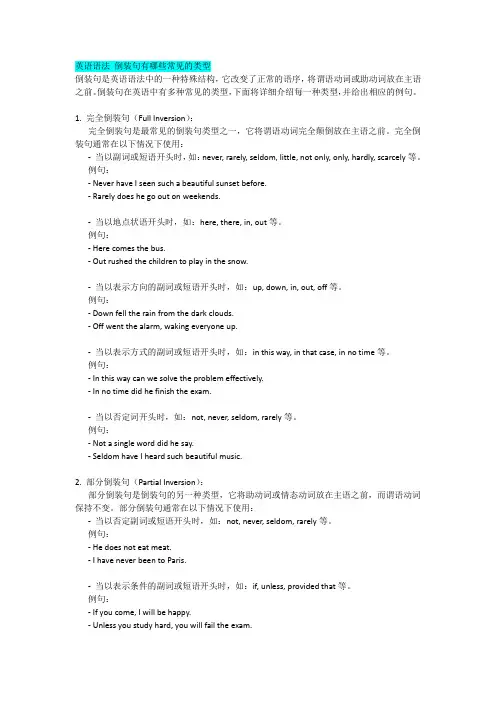
英语语法倒装句有哪些常见的类型倒装句是英语语法中的一种特殊结构,它改变了正常的语序,将谓语动词或助动词放在主语之前。
倒装句在英语中有多种常见的类型,下面将详细介绍每一种类型,并给出相应的例句。
1. 完全倒装句(Full Inversion):完全倒装句是最常见的倒装句类型之一,它将谓语动词完全颠倒放在主语之前。
完全倒装句通常在以下情况下使用:-当以副词或短语开头时,如:never, rarely, seldom, little, not only, only, hardly, scarcely等。
例句:- Never have I seen such a beautiful sunset before.- Rarely does he go out on weekends.-当以地点状语开头时,如:here, there, in, out等。
例句:- Here comes the bus.- Out rushed the children to play in the snow.-当以表示方向的副词或短语开头时,如:up, down, in, out, off等。
例句:- Down fell the rain from the dark clouds.- Off went the alarm, waking everyone up.-当以表示方式的副词或短语开头时,如:in this way, in that case, in no time等。
例句:- In this way can we solve the problem effectively.- In no time did he finish the exam.-当以否定词开头时,如:not, never, seldom, rarely等。
例句:- Not a single word did he say.- Seldom have I heard such beautiful music.2. 部分倒装句(Partial Inversion):部分倒装句是倒装句的另一种类型,它将助动词或情态动词放在主语之前,而谓语动词保持不变。
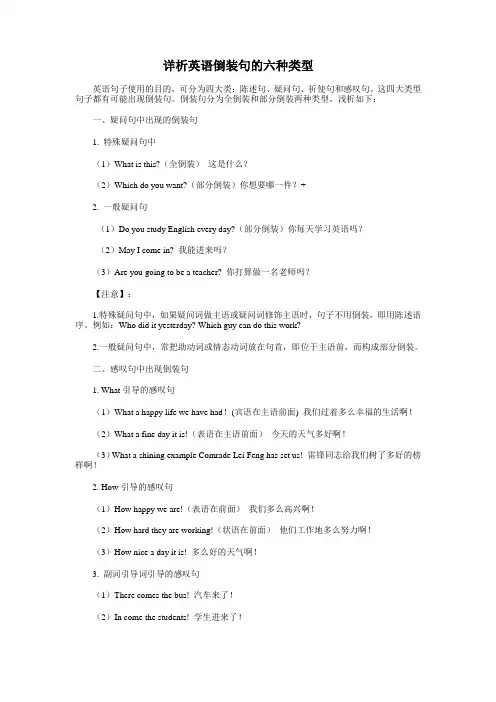
详析英语倒装句的六种类型英语句子使用的目的,可分为四大类:陈述句、疑问句、祈使句和感叹句。
这四大类型句子都有可能出现倒装句。
倒装句分为全倒装和部分倒装两种类型。
浅析如下:一、疑问句中出现的倒装句1. 特殊疑问句中(1)What is this?(全倒装)这是什么?(2)Which do you want?(部分倒装)你想要哪一件?+2. 一般疑问句(1)Do you study English every day?(部分倒装)你每天学习英语吗?(2)May I come in? 我能进来吗?(3)Are you going to be a teacher? 你打算做一名老师吗?【注意】:1.特殊疑问句中,如果疑问词做主语或疑问词修饰主语时,句子不用倒装,即用陈述语序。
例如:Who did it yesterday? Which guy can do this work?2.一般疑问句中,常把助动词或情态动词放在句首,即位于主语前,而构成部分倒装。
二、感叹句中出现倒装句1. What引导的感叹句(1)What a happy life we have had!(宾语在主语前面) 我们过着多么幸福的生活啊!(2)What a fine day it is!(表语在主语前面)今天的天气多好啊!(3)What a shining example Comrade Lei Feng has set us! 雷锋同志给我们树了多好的榜样啊!2. How引导的感叹句(1)How happy we are!(表语在前面)我们多么高兴啊!(2)How hard they are working!(状语在前面)他们工作地多么努力啊!(3)How nice a day it is! 多么好的天气啊!3. 副词引导词引导的感叹句(1)There comes the bus! 汽车来了!(2)In come the students! 学生进来了!(3)Off goes the worker! 工人下车了!【注意】:1. What或how 引导的句子,主谓也有不倒装的。
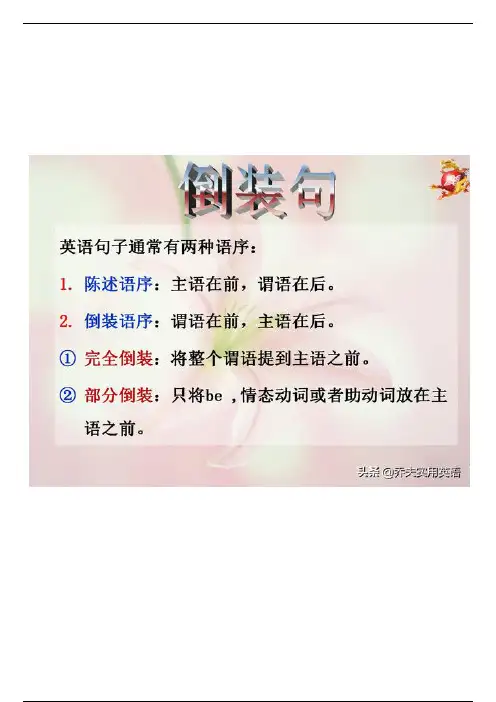
英语句子通常有两种语序:陈述语序和倒装语序。
陈述语序是主语在前,谓语在后;倒装语序是谓语在前,主语在后。
倒装语序又分完全倒装和部分倒装。
一、完全倒装:将整个谓语提到主语之前1.在There be (exist, happen, live, appear, lie, occur, rise, seem, come, remain, stand等)句型中。
(1)There are at least 2000 people on the square.至少有2000人在广场上(主语是2000 (2)people, 谓语动词是are)(3)There stood a dog before him.一只狗站在他面前(主语是a dog)(4)There exist different opinions on this question.关于这个问题,有不同的意见存在(主语是different opinions)2. 以here, there, now, then等开头的句子。
(1)Here is the seat for you. 这儿有一个座位给你(主语是the seat)(2)There goes the bell . 铃声响了(主语是the bell)(3)Now comes your turn . 轮到你了(主语是your turn)(4)Then followed three days of heavy rain . 接下来是三天的大雨(主语是heavy rain)3. 在象声词或以out, in, up, down, away等副词开头的句子里。
(1)Crackle, crackle came the gun and the young soldier felt very frightened.枪声叭叭作响,这个年轻的士兵感到很害怕。
(主语是the gun)(2)Out rushed the children . 孩子们冲了出去。
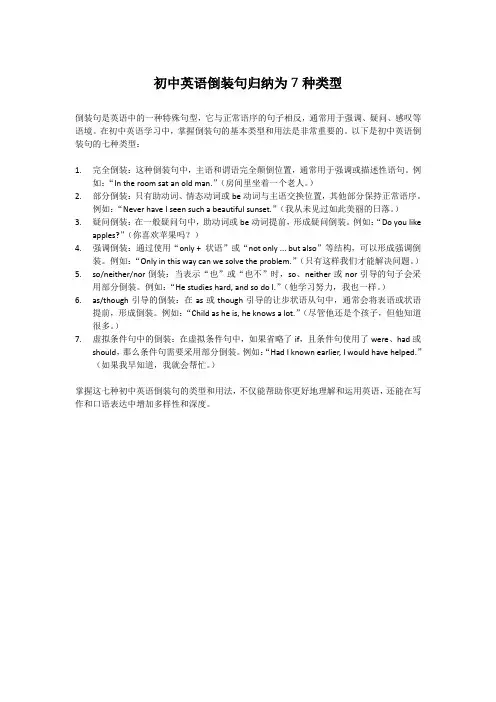
初中英语倒装句归纳为7种类型倒装句是英语中的一种特殊句型,它与正常语序的句子相反,通常用于强调、疑问、感叹等语境。
在初中英语学习中,掌握倒装句的基本类型和用法是非常重要的。
以下是初中英语倒装句的七种类型:1.完全倒装:这种倒装句中,主语和谓语完全颠倒位置,通常用于强调或描述性语句。
例如:“In the room sat an old man.”(房间里坐着一个老人。
)2.部分倒装:只有助动词、情态动词或be动词与主语交换位置,其他部分保持正常语序。
例如:“Never have I seen such a beautiful sunset.”(我从未见过如此美丽的日落。
)3.疑问倒装:在一般疑问句中,助动词或be动词提前,形成疑问倒装。
例如:“Do you likeapples?”(你喜欢苹果吗?)4.强调倒装:通过使用“only + 状语”或“not only ... but also”等结构,可以形成强调倒装。
例如:“Only in this way can we solve the problem.”(只有这样我们才能解决问题。
)5.so/neither/nor倒装:当表示“也”或“也不”时,so、neither或nor引导的句子会采用部分倒装。
例如:“He studies hard, and so do I.”(他学习努力,我也一样。
)6.as/though引导的倒装:在as或though引导的让步状语从句中,通常会将表语或状语提前,形成倒装。
例如:“Child as he is, he knows a lot.”(尽管他还是个孩子,但他知道很多。
)7.虚拟条件句中的倒装:在虚拟条件句中,如果省略了if,且条件句使用了were、had或should,那么条件句需要采用部分倒装。
例如:“Had I known earlier, I would have helped.”(如果我早知道,我就会帮忙。
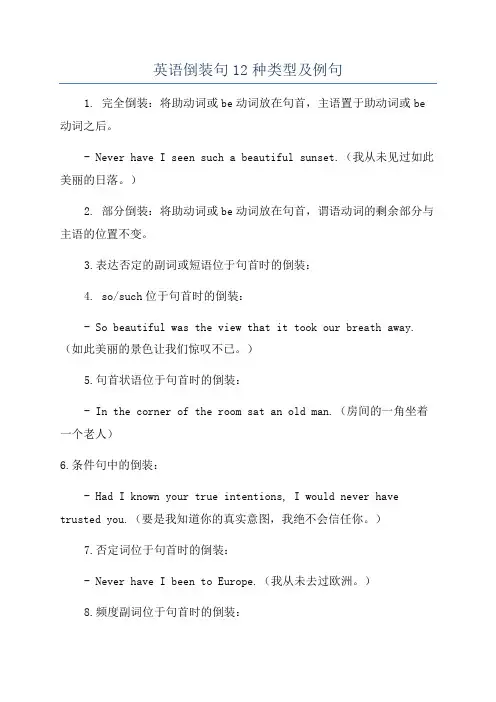
英语倒装句12种类型及例句1. 完全倒装:将助动词或be动词放在句首,主语置于助动词或be 动词之后。
- Never have I seen such a beautiful sunset.(我从未见过如此美丽的日落。
)2. 部分倒装:将助动词或be动词放在句首,谓语动词的剩余部分与主语的位置不变。
3.表达否定的副词或短语位于句首时的倒装:4. so/such位于句首时的倒装:- So beautiful was the view that it took our breath away.(如此美丽的景色让我们惊叹不已。
)5.句首状语位于句首时的倒装:- In the corner of the room sat an old man.(房间的一角坐着一个老人)6.条件句中的倒装:- Had I known your true intentions, I would never have trusted you.(要是我知道你的真实意图,我绝不会信任你。
)7.否定词位于句首时的倒装:- Never have I been to Europe.(我从未去过欧洲。
)8.频度副词位于句首时的倒装:- Rarely do we see such dedication.(我们很少见到如此的奉献精神。
)9.祈使句或祈使句部分的倒装:- Stand up!(站起来!)- Be quiet, please.(请安静。
)10. only位于句首时的倒装:- Only by working hard can you achieve your goals.(只有通过努力工作,你才能实现目标。
)11.地点状语置于句首时的倒装:- In the garden were beautiful flowers.(花园里有美丽的花朵。
)12.宾语置于句首时的倒装:- A love like this I have never felt before.(我之前从未感受过如此的爱。
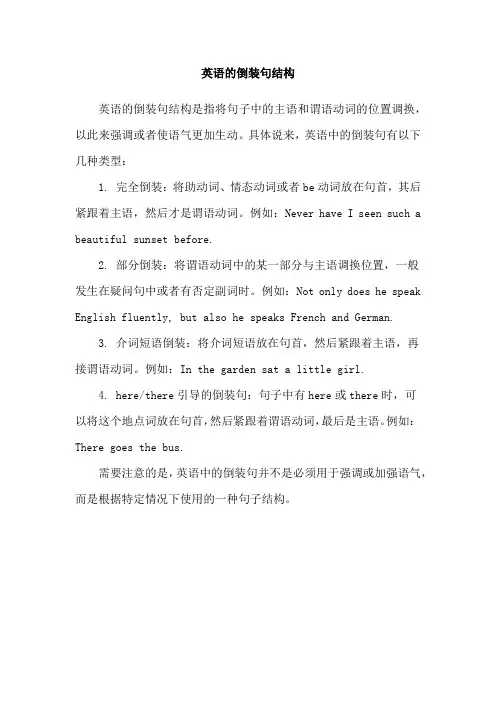
英语的倒装句结构
英语的倒装句结构是指将句子中的主语和谓语动词的位置调换,以此来强调或者使语气更加生动。
具体说来,英语中的倒装句有以下几种类型:
1. 完全倒装:将助动词、情态动词或者be动词放在句首,其后紧跟着主语,然后才是谓语动词。
例如:Never have I seen such a beautiful sunset before.
2. 部分倒装:将谓语动词中的某一部分与主语调换位置,一般
发生在疑问句中或者有否定副词时。
例如:Not only does he speak English fluently, but also he speaks French and German.
3. 介词短语倒装:将介词短语放在句首,然后紧跟着主语,再
接谓语动词。
例如:In the garden sat a little girl.
4. here/there引导的倒装句:句子中有here或there时,可
以将这个地点词放在句首,然后紧跟着谓语动词,最后是主语。
例如:There goes the bus.
需要注意的是,英语中的倒装句并不是必须用于强调或加强语气,而是根据特定情况下使用的一种句子结构。
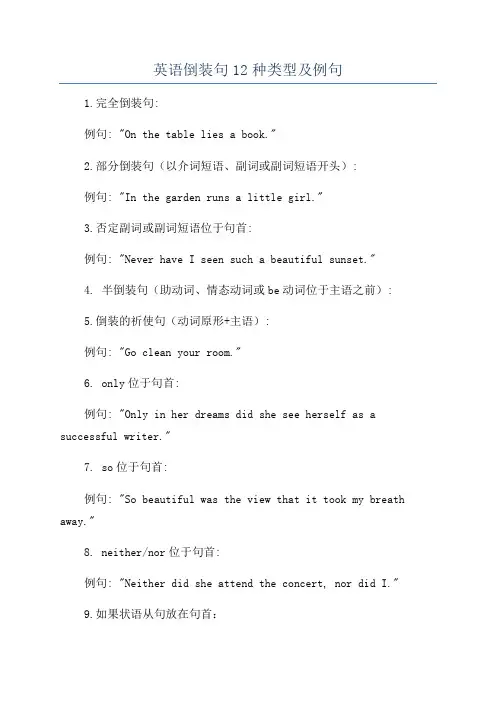
英语倒装句12种类型及例句1.完全倒装句:例句: "On the table lies a book."2.部分倒装句(以介词短语、副词或副词短语开头):例句: "In the garden runs a little girl."3.否定副词或副词短语位于句首:例句: "Never have I seen such a beautiful sunset."4. 半倒装句(助动词、情态动词或be动词位于主语之前):5.倒装的祈使句(动词原形+主语):例句: "Go clean your room."6. only位于句首:例句: "Only in her dreams did she see herself as a successful writer."7. so位于句首:例句: "So beautiful was the view that it took my breath away."8. neither/nor位于句首:例句: "Neither did she attend the concert, nor did I."9.如果状语从句放在句首:10.条件从句位于句首:例句: "Should he fail the exam, he will have to retake the course."11.介词短语或副词短语位于句首:例句: "In the corner sat a small dog."12. or/ nor引导的短语或句子位于句首:。
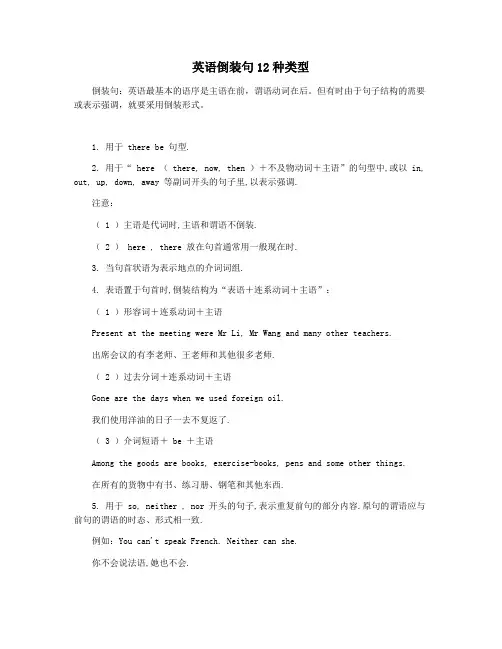
英语倒装句12种类型倒装句:英语最基本的语序是主语在前,谓语动词在后。
但有时由于句子结构的需要或表示强调,就要采用倒装形式。
1. 用于 there be 句型.2. 用于“ here ( there, now, then )+不及物动词+主语”的句型中,或以 in, out, up, down, away 等副词开头的句子里,以表示强调.注意:( 1 )主语是代词时,主语和谓语不倒装.( 2 ) here , there 放在句首通常用一般现在时.3. 当句首状语为表示地点的介词词组.4. 表语置于句首时,倒装结构为“表语+连系动词+主语”:( 1 )形容词+连系动词+主语Present at the meeting were Mr Li, Mr Wang and many other teachers.出席会议的有李老师、王老师和其他很多老师.( 2 )过去分词+连系动词+主语Gone are the days when we used foreign oil.我们使用洋油的日子一去不复返了.( 3 )介词短语+ be +主语Among the goods are books, exercise-books, pens and some other things.在所有的货物中有书、练习册、钢笔和其他东西.5. 用于 so, neither , nor 开头的句子,表示重复前句的部分内容.原句的谓语应与前句的谓语的时态、形式相一致.例如:You can't speak French. Neither can she.你不会说法语,她也不会.6. 为了保持句子平衡,或为了强调表语或状语,或是上下文紧密衔接时.例如: They arrived at a small village, in front of which was a big river.他们来到一个小村庄,村庄前面是条大河.1. 否定副词位于句首时的倒装在正式文体中,never, seldom, rarely, little, hardly, scarcely, no sooner, no longer, nowhere 等含有否定意义的副词若位于句首,则其后要用部分倒装:I shall never forgive him. / Never shall I forgive him. 我永远不会宽恕他。

英语倒装句结构英语句子表达的基本语序是“主语+谓语”。
但在实际应用中,因语法结构的需要,或是为了强调,常把谓语移到主语之前,称为倒装。
英语的倒装结构有两种,其中较为常见的是部分倒装,即谓语的一部分移到主语之前。
如:Only when the war was over could he begin to work again.只有在战争结束后他才能够重新开始工作。
另一种倒装是完全倒装结构,即把谓语的全部都移到主语之前。
如:1.Here comes the bus.公共汽车来了。
2.“But what the child said is true.” said the father.“可是孩子的话是对的。
”父亲说。
下面详细归纳几种常用的倒装结构。
1、几种常见的部分倒装布局:1.Only+状语或者状语从句放在句首。
如:Only in this way can we improve our English.只有这样,我们才能提高英语水平。
Only after you left did l find this bag.只是在你分开当前我才发觉这只提包。
2.含否定意义并修饰全句的词放在句首。
如:not,little, hardly, scarcely,no more, no longer, in no way, never, seldom, not only, no sooner等等。
如:1)Seldom do I go to work by bus.我很少乘大众汽车上班。
2)Never shall I forget it.我永久不会遗忘这件事。
3)No sooner had I got home than it began to rain.我刚一到家,天就开始下雨。
3.So放在句首,跟在一个肯定句之后,表示前面所述内容也适用于另一人或物。
如:1)l XXX.我喜欢旅行,他也喜欢。
2)Her XXX.她父亲是位医生,她母亲也是。
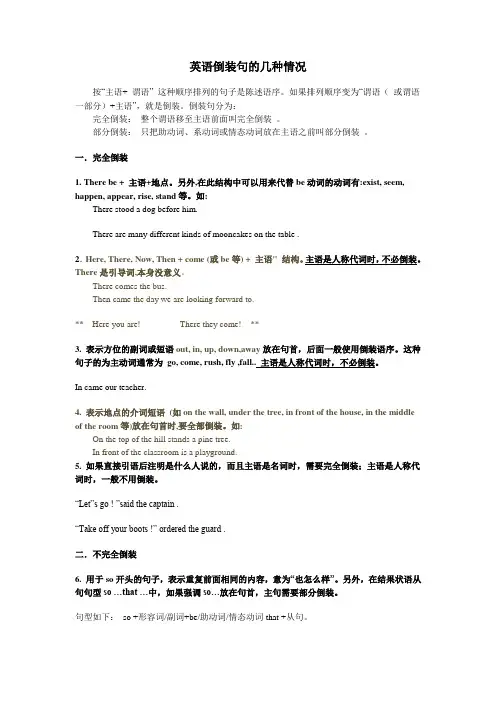
英语倒装句的几种情况按“主语+ 谓语” 这种顺序排列的句子是陈述语序。
如果排列顺序变为“谓语(或谓语一部分)+主语”,就是倒装。
倒装句分为:完全倒装:整个谓语移至主语前面叫完全倒装。
部分倒装:只把助动词、系动词或情态动词放在主语之前叫部分倒装。
一.完全倒装1. There be + 主语+地点。
另外,在此结构中可以用来代替be动词的动词有:exist, seem, happen, appear, rise, stand等。
如:There stood a dog before him.There are many different kinds of mooncakes on the table .2.Here, There, Now, Then + come (或be等) + 主语" 结构。
主语是人称代词时,不必倒装。
There是引导词,本身没意义。
There comes the bus.Then came the day we are looking forward to.**Here you are! There they come!**3. 表示方位的副词或短语out, in, up, down,away放在句首,后面一般使用倒装语序。
这种句子的为主动词通常为go, come, rush, fly ,fall.. 主语是人称代词时,不必倒装。
In came our teacher.4. 表示地点的介词短语(如on the wall, under the tree, in front of the house, in the middle of the room等)放在句首时,要全部倒装。
如:On the top of the hill stands a pine tree.In front of the classroom is a playground.5. 如果直接引语后注明是什么人说的,而且主语是名词时,需要完全倒装;主语是人称代词时,一般不用倒装。
倒装句七种英语结构倒装句是英语中一个常见的语法结构,它可以增强语言的表现力和表达的重点。
下面是七种常见的英语倒装句结构:1. 完全倒装句:将助动词或be动词放在主语之前,用于强调语序。
例如:Never have I seen such a beautiful sunset.2. 部分倒装句:将助动词或be动词和主语中间的词组交换位置,用于强调这个词组。
例如:At the end of the street stands a beautiful church.3. 一般疑问句倒装:将助动词放在主语之前,用于询问。
例如:Do you like coffee? -> Like you coffee?4. 否定疑问句倒装:将助动词和not连用放在主语之前,用于询问带有否定意义的问题。
例如:You don't like coffee, do you? -> Like you coffee or not?5. 情态动词倒装:将情态动词放在主语之前,用于强调语气。
例如:You must study hard. -> Must you study hard?6. only修饰副词或介词短语倒装:将only和它所修饰的副词或介词短语放在句首,用于强调。
例如:Only in this way can you solve the problem.7. 地点状语倒装:将表示地点的副词或介词短语放在句首,用于强调。
例如:In the garden sat a young couple.以上七种倒装句结构都可以增强语言的表现力和表达的重点,当然在日常表达中也要注意使用适当的语言结构,以便更加自然流畅地表达意思。
英语的倒装句
英语最基本的词序是主语在谓语动词的前面。
如果将句子的主语和谓语完全颠倒过来,这称之为完全倒装。
如果只将助动词或情态动词移至主语之前,谓语的其他部分仍保留在主语的后面,这称之为部分倒装。
一. 完全倒装
完全倒装是将谓语的全部放在主语之前,此结构通常只用于一般现在时和一般过去时两种。
On her left sat her husband.她左边坐着她丈夫。
Here is the book you want.你要的书在这儿。
Down went the small boat.小船沉下去了。
二. 部分倒装
部分倒装是指将谓语的一部分,如助动词或情态动词,移至主语之前。
Only by working hard can one succeed.只有努力才能成功。
Never have I seen her before.我以前没见过她。
提示:如果句中的谓语没有助动词或情态动词,则需添加助动词do, does 或did,并将其置于主语之前。
Well do I remember the day I joined the League.入团的那一天,我记忆犹新。
Little did I think that he could be back alive .我没有想到他竟能活着回来。
英语倒装句Company Document number:WUUT-WUUY-WBBGB-BWYTT-1982GT英语倒装句倒装有两种:一将主语和谓语完全颠倒过来,叫做完全倒装。
如:In came a man with a white beard.二只将助动词(包括情态动词)移至主语之前,叫做部分倒装。
如:Only once was John late to class.英语句子的倒装一是由于结构的需要而进行的倒装,二是由于修辞的需要而进行的倒装。
前一种情况,倒装是必须的,否则就会出现语法错误;后一种情况,倒装是选择性的,倒装与否只会产生表达效果上的差异。
一完全倒装的四种主要类型(有地钻状洞动)1. here 和there、now、 then位于句首时的倒装表示地点的here和 there位于句首时,其后用完全倒装形式。
这类倒装句的谓语通常是动词be和come, go等表示移动或动态的不及物动词:Here’s Tom. 汤姆在这里。
There’s Jim. 吉姆在那儿。
Here comes the bus. 公共汽车来了。
There goes the bell. 铃响了。
There goes the last train. 最后一班火车开走了。
【注意】(1)以上倒装句中的谓语动词come和go不能用进行时态,即不能说Here is coming the bus。
(2) 若主语为代词,则不倒装:Here I am. 我在这儿。
/ 我来了。
Here it comes. 它来了。
(3) 其中的动词有时也可能是stand, lie, live等表示状态的动词(表示存在):There stood a desk against the wall. 靠墙放着一张书桌。
Once upon a time there lived a man known by the name of Beef. 从前有个人名叫比夫。
英语倒装句12种类型1、“there be”结构在这一结构里,there是引导词,主语在be后。
2、疑问句疑问句为倒装形式。
3、here、there等副词开头的句子(部分)。
在here、there等副词开头的某些句子中(要用一般现在时态)(前两个例句);如果主语是人称代词,主语和主要动词的词序不变。
(完全倒装)4、重复倒装句型在以so、nor、neither开头,表示谓语所述的情况也适用于另一个人或一事物的肯定或否定句中。
so用于肯定句,表示“也一样”、“也这样”;nor、neither用于否定句,表示“同样也不,也不这样”。
5、直接引语的全部或一部分放在句首时,主句中的主谓也常直接倒装(完全倒装)。
6、否定副词开头的句子(部分倒装) 在以never、little、hardly、not、only、few、not、seldom等否定副词开头的句子中,采用部分倒装;如果不放在句首就不要倒装。
7、以only所修饰的副词、介词短语或状语从句的句子。
8、地点、方位副词在句首(完全倒装) 为了表达生动,有时把表地点、方位的副词,如up、down、out、away、in等放在句首,同时把谓语动词放在主语之前。
若主语为人称代词,主语和谓语动词的位置不变,只将副词放在句首。
(完全倒装)9、虚拟结构中在虚拟结构中,条件从句的谓语含有were、had和should这三个词是,可省去if,将这些词移至主语之前。
10、as引导的让步状语从句 as引导让步状语从句时要倒装(形容词/副词/名词/动词+as+主语+谓语)。
11、祝愿的句子用于某些表示祝愿的句子里。
12、So+形容词、副词及such置于句首时。
英语语法“倒装句”超级大汇总英语最基本的词序是主语在谓语动词的前面。
如果将句子的主语和谓语完全颠倒过来,这称之为完全倒装。
如果只将助动词或情态动词移至主语之前,谓语的其他部分仍保留在主语的后面,这称之为部分倒装。
下面是小简老师为同学们整理的倒装句的内容,一起来学习吧↓↓↓一.部分倒装1.否定副词位于句首时的倒装在正式文体中,never, seldom, rarely, little, hardly, scarcely, no sooner, no longer, nowhere 等含有否定意义副词若位于句首,则其后要用部分装:①I shall never forgive him. / Never shall I forgive him. 我永远不会宽恕他。
②He seldom goes out for dinner. / Seldom does he go out for dinner. 他很少出去吃饭。
③She hardly has time to listen to music. / Hardly does she have time to listen to music. 她几乎没时间听音乐。
④He little realizes how important this meeting is. / Little does he realize how important this meeting is. 他不甚明白这个会议的重要性。
⑤We had no sooner reached the airport than the plane took off. / No sooner had we reached the airport than the plane took off. 我们刚到机场,飞机就起飞了。
注意(1) 对于not…until句型,当not until…位于句首时,其后的主句要用倒装语序:He didn’t leave the room until the rain stopped. / Not until the rain stopped did he leave the room. 雨停了之后他才离开这房间。
倒装句倒装分两类:全部倒装和部分倒装。
全部倒装是将句子中的谓语动词全部置于主语之前。
实义动词、情态动词或be 动词放在主语之前。
部分倒装是指将谓语的一部分如助动词或情态动词倒装至主语之前。
如果句中的谓语没有助动词或情态动词,则需添加助动词do, does或did,并将其置于主语之前。
口诀速记:副词开头要倒装,人称代词则如常。
only修饰副介状,位于句首半倒装。
否定意义副连词,“既不……也不”需倒装。
表语前置主语长,衔接自然常倒装。
such 代词作表语,引起主谓要倒装。
not only开头句,前一分句需倒装。
had,were,should虚拟句,省略if半倒装。
1.全部倒装的情况2. 部分倒装的情况1. [2009·辽宁卷] ________ is the power of TV that it can make a person suddenly famous.A.Such B.This C.That D.So4. Not until quite recently ________ that language is closely related to culture.A.he realized B.did he realizeC.had he realized D.he did realize7. [2010·重庆卷] At the meeting place of the Yangtze River and the Jialing River ________,one of the ten largest cities in China.A.lies ChongqingB.Chongqing liesC.does lie ChongqingD.does Chongqing lie9. [2010·四川卷] We laugh at jokes,but seldom ________ about how they work.A.we think B.think weC.we do think D.do we think12.________in the root of his family that he decided to make a trip to Africa for further research.A.So interested Kunta wasB.So interested was KuntaC.How interested Kunta wasD.Kunta was such interested15.(2011·浙江金华十校联考)Not until the press reported the pollution________why the water supply had been cut off.A.people did know B.people had knownC.had people known D.did people know16.(2011·湖南十二校第二次联考)—We have to stop talking here outside.Listen,________!—Hurry up,or we’ll be late.A.there goes the bell B.there does the bell goC.there the bell goes D.goes the bell there 17.(2011·东城练习二)Only when Tom fully recovered________back to work.A.did he go B.he wentC.had he gone D.he had gone18.(2011·苏锡常镇四市教学调查)Not only________know the theory,but also ________learn how to apply it in practice.A.should we;should we B.we should;we shouldC.should we;we should D.we should;should we 19.(2011·东北三省四市联考)Such a great event ________that it will attract governments and people from across the world to Shanghai.A.is World Expo 2010B.World Expo 2010 isC.has World Expo 2010 beenD.World Expo 2010 has been20.(2010·九江地区联考)Hardly________the phone________I was told that the hotel had been booked full.A.I had picked up;when B.had I picked up;thenC.had I picked up;when D.I had picked up;then。
英语倒装句类型
本文从网络收集而来,上传到平台为了帮到更多的人,如果您需要使用本文档,请点击下载按钮下载本文档(有偿下载),另外祝您生活愉快,工作顺利,万事如意!
嘉应中学罗淑芬英语句子使用的目的,可分为四大类:陈述句、疑问句、祈使句和感叹句。
这四大类型句子都有可能出现倒装句。
倒装句分为全倒装和部分倒装两种类型。
浅析如下:
一、疑问句中出现的倒装句
1.特殊疑问句中
(1)whatisthis?(全倒装)
(2)whichdoyouwant?(部分倒装)
2.一般疑问句
(1)DoyoustudyEnglisheveryday?(部分倒装)
(2)mayIcomein?
(3)Areyougoingtobeateacher?
特殊疑问句中,如果疑问词做主语或疑问词修饰主语时,句子不用倒装,即用陈述语序。
例如:whodidityesterday?whichguycandothiswork?
一般疑问句中,常把助动词或情态动词放在句首,即位于主语前,而构成部分倒装。
二、感叹句中出现倒装句
引导的感叹句
(1)whatahappylifewehavehad!
(2)whatafinedayitis!(表语在主语前面)
(3)whatashiningexamplecomradeLeiFenghassetus!
引导的感叹句
(1)Howhappyweare!(表语在前面)
(2)Howhardtheyareworking!(状语在前面)
(3)Howniceadayitis!
3.副词引导词引导的感叹句
(1)Therecomesthebus!
(2)Incomethestudents!
(3)offgoestheworker!
what或how引导的句子,主谓也有不倒装的。
what所强调的重点是名词,这一名词一般是表语或宾语,有时所强调的名词可能是主语。
例如:whatenormouscrowdcame!(《当代英语语法》中册P87)。
what也可单独使用。
例句:whatshesufferedintheolddays!(《英语分类句型》P90)
How修饰形容词、副词或动词。
有时howmany 的搭配也可修饰名词。
ForhowmanyyearshaveIwaited!该短语作状语。
(《当代英语语法》)
副词引导词位于句首,一方面为了强调,另一方
面使情景生动。
主语是名词时,主谓倒装;如果主语是人称代词,主谓不倒装。
例如:Awayhewenttothestation!
三、祈使句中出现的倒装
!(《最新实用英汉辞典》P769)
’sRepublicofchina!
!祝你成功!
Longmayhelive!愿他长命百岁!(《英华大辞典》P780)
’’tanyoneopenthedoor.(《当代英语语法》中册P85)
祈使句一般无主语,有时也有主语出现。
祈使句的主语要重读,代词也要重读(陈述句的主语一般不重读)。
祈使句常用句号。
表示一种强烈感情时,句子用感叹号。
四、陈述句中出现的几种倒装句
1.主谓倒装
(1)Longlongago,therewasawarbetweenthebirdsandthebeasts.
(2)onceuponatimethereweresixblindmeninIndia.
(3)“comealong,then.”saidthebird.
(4)...buttowardtheendtherecametheterriblestorm...
2.表语倒装
(1)SuchwasAlbertEinstein,asimplemanofgreatachievements.(全倒装句)
(2)Insidethepyramidsaretheroomsforthebodiesofkingsandqu eens.
(3)Averyreliablepersonheis.(主语是人称代词时,主谓不倒装)(《英语分类句型》P400)
3.宾语倒装
(1)manyhappyhoursshehadspentplanningforsomethingnicef orhim.
(2)Twenty-onedollarstheytookforit.
(3)Notasinglemistakedidhemake.
(4)onlyadictionaryheneverforgetstobringhere.
宾语在前时,多数属于强调部分,句子一般不加助动词,偶尔也有助动词出现,如例句(3)。
五、复合句中的倒装
(1)ItakebackwhatIsaid.
(2)...andtheshipwouldhavesunkwithallboardhaditnotb eenforthecaptain.(要是没有那位船长,就会连船带人
都沉没了。
)
(3)wereIyou,Iwouldgowithhim.
(4)Proudasthesenoblesare,heisafraidtoseeme.
(5)Notonlywaseverythingthathehadtakenawayfromhim,butalsohisGermancitizenship.
(6)Hardlyhadhesatdownwhenthetelephonerang.
(7)Theharderyouwork,thegreaterwillbeyourachievement.
六、其他倒装
陈述句中为了保持句子平衡或为了强调表语、宾语、状语等成分,或使上下文紧密衔接时,使用倒装句。
(1)onthewallisablackboardonwhichwerewrittensomewords,“Itisnousesittingherewithoutlisteningtome.”(定语从句中,主语的同位语太长)
(2)Theyenteredtheclassroom,infrontofwhichsatanaughtyboy.(使上下文紧密衔接)
(3)Goneforeverarethedayswhenthechinesepeoplewerelooked downuponbytheforeigners.(主语加上定语后太长而表
语短,所以表语在前面,强调句子平衡)
本文从网络收集而来,上传到平台为了帮到更多的人,如果您需要使用本文档,请点击下载按钮下载本文档(有偿下载),另外祝您生活愉快,工作顺利,万事如意!。